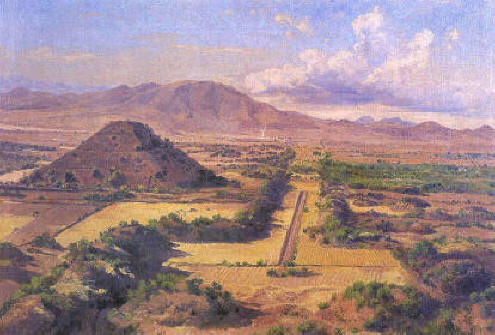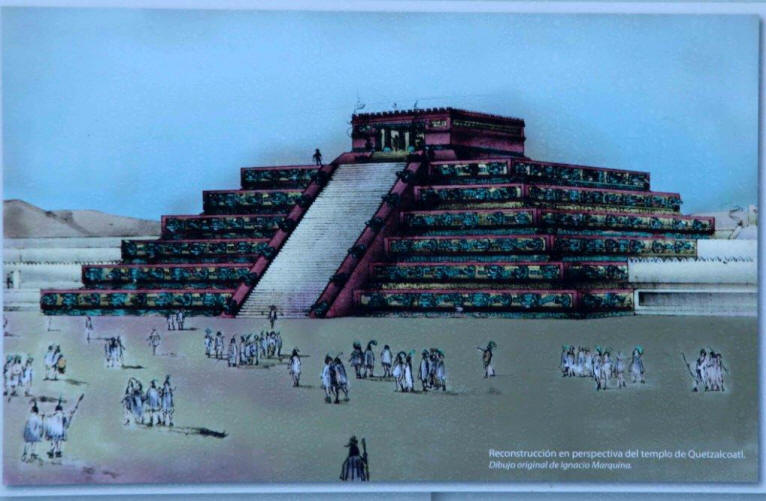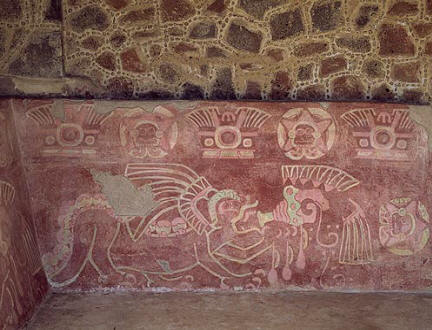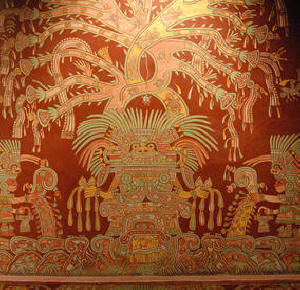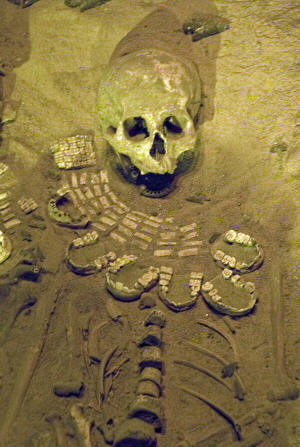|
Home
Planning
& Info
Regions RVing
Archeology
Articles
Road Logs Insurance
Photos
Mexico
News Ontheroadin |
|
Teotihuacan - Historical Notes by Dorothy and Bill Bell
1878 picture of Avenue of the Dead
Scientists are not clear on who the original inhabitants were. Many believed it was the Toltecs (including the Aztecs who occupied the city next) but now it is believed that the people were multi-ethnic groups who settled together in the area. They did not leave any written records or codes to decipher. Even the original name of the City is lost.
Teotihuacan’s ceremonial center is what the present day visitor sees today - only five percent has been scientifically excavated. The builders worked without the wheel or beast of burden to produce the glorious City. Teotihuacan was started as a new religious center 200 BC and the major building of this massive site began around the time of Christ from 1 to 200 AD. and became the most populous and most important city in the New World. Using precise astronomical measurements, these people created a replica of the sky and mirrored the alignment of the stars in the city plans. The City and culture peaked around 500 AD and covered 31 square km (12 square miles) and was larger in population and size than Rome. Teotihuacan was then the sixth largest city in the world and had an estimated population of 125,000.
The temples, palaces and pyramids were covered with a limestone stucco and painted with bright colors. The original red paint can still be spotted on many of the buildings. There were many and elaborate and detailed murals, sculptures and detailed carvings. As the major urban center in the what would be called the New World, Teotihuacan developed new agricultural production methods, new technology, and a broad trading circle. Her influences were felt throughout Mexico and into Central America. It had a developed religious system that influence and spread to other areas. It had no defensive walls or compounds. It was simply the supreme power. The Teotihanicans had many highly developed skills and were considered craftsmen. Their products were widely desired and traded throughout the ancient world as far away as Guatemala and the Yucatan. The artistry found in the murals, sculptures and architecture itself is stunning. They excelled in astronomy, mathematics and religion. There is evidence of a water system and drainage in the city. Religion and ceremony were an important part of the Teotihuacans life. People from throughout Mexico would come to the City in awe of its beauty for the rituals and ceremonies. From their art; handicrafts murals and sculptures, buildings and sacrificial offerings, scientists have concluded that the society was polytheistic; worshiping many gods, who are associated with various functions. Central to their beliefs was that Teotihuacan was where the earth was born. Caves and tunnels are sacred linking the underworld and spiritual with man. Gods were to be appeased to ensure that the Gods were satisfied and would bless the city and the population. They would also avert the end of the world. While the names of the Teotihuacans divinities are not known, many of the dieties were adopted by the Aztecs and can be assumed to be similar in nature. Important Gods central to their belief system were the Great Goddess of Creation, Tlaloc was the Storm God, the Feathered Serpent for fertility of the earth, the Old God Huehueteotl patron God of the house.
Jaguar in the Jaguar Patio at Teotihuacan
Human and animal sacrifices appear to be offered to commemorate a new building or a major extension of a building. Sacred animals were mainly puma, wolf, owl, eagle, hawk, snake and of course jaguar. While many were native Teotihuacans, other human sacrifices appear to be prisoners captured in various battles and wars. The point of war was to bring captives to sacrifice to the Gods NOT to merely kill the enemy in the field.
The Exodus The inhabitants of Teotihuacan abandoned the city around 7000 AD. A few theories include overpopulation, natural disaster, famine and disgruntlement with the ruling and religious class. One theory is that poorer classes carried out an internal uprising against the ruling and religious elite. 50 years after the city was abandoned there was a great fire that buried many of the buildings and artifacts with ash. Many important temples were desecrated. It has been suggested that the arsonists were the former inhabitants who wanted to destroy the city. Others say it was the Toltecs who wanted to debase the Teotihuacan’s religion. Long after the exodus around 1320, the Aztecs took over the metropolis and named Teotihuacan “Birthpalce of the Gods” recognizing its sacred import and architectural genius. It was highly revered as the most sacred spot on the earth and they pilgrimaged here from their base in Tenochtitlán; Mexico City. The Aztecs adopted many of the Gods and mythology and believed the moon, the sun and the universe were created at Teotihuacan.. Teotihuacan was declared a World Heritage Site by UNESCO in 1987
|
*
The Great Goddess
A Sacrifical Victim
|
|
|
What You Should Consider for Your Visit
|
|
On the Road In - Mexico
editor@ontheroadin.com

